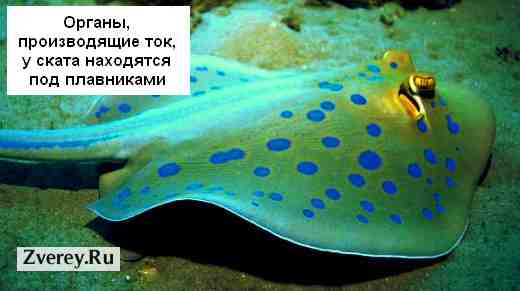Many readers of the site about animals know that there are fish that have the ability to beat with electric shock (in the literal sense), but not everyone knows how this is done. We propose to consider the two most famous marine representatives that generate current: electric stingray and electric eel. You will learn:
- is the current of these electric fish dangerous for humans;
- how the organs that produce electricity are arranged in the stingray and eel;
- how stingrays and eels hunt and catch prey;
- how live fish are associated with the New Year holiday.
Electric ramp - living battery
Electric stingrays are mostly medium-sized - from 50 to 60 cm, however, there are individuals that reach a length of 2 m. Small-sized representatives of these fish create an insignificant electric charge, and in turn, large stingrays discharge 300 volts. The organs of the individual that produce current make up 1/6 of the body and are very developed. They are located on both sides - they occupy a place between the fin of the chest and the head part, and they can be seen from the dorsal and abdominal parts.
The internal organs of the fish that produce electricity have the following structure. A certain number of columns that make up the electrical plates and the bottom of the plate, like the entire body, is negatively charged, and the top is positively charged.

During the hunt, the stingray strikes its prey by wrapping its fins around it, where the organs that produce electricity are located. During this process, an electrical charge is applied and the prey is electrocuted to death. The slope is similar to a battery. If he uses the charge entirely, then he will need a few but then to "charge" again.
A ramp without a charge is safe, however, if it has a charge, then a person can be seriously injured by a strong electrical discharge. No fatal incidents have been identified, although someone who touches the stingray may experience low blood pressure, heart rhythm disturbances, and spasms may appear, and swelling of local tissues appears in the affected area. The stingray is inactive and mostly lives at the bottom, therefore, in order not to meet it in the aquatic environment, it is necessary to pay attention while being in shallow water.

In the days of Ancient Rome, on the contrary, electrical discharges were recognized (and are now recognized in medicine) as healing. It was believed that the electric shock could relieve headaches and alleviate gout. Even today, on the shores of the Mediterranean, older people deliberately walk barefoot in shallow water in order to alleviate rheumatism and gout with electric shocks.
Electric eel lit garlands on the Christmas tree
And now a note, although about fish, but it concerns such a holiday as the New Year! It would seem how live fish and a New Year tree are combined? That's how. Read on.

Most representatives of the electric eel group are from 1 to 1.5 m long, but there are species that reach three meters. In such individuals, the impact force reaches 650 volts. People who are struck by electric shock in water can lose consciousness and drown. Electric eel is one of the most dangerous representatives of the Amazon River. An eel rises to the surface about every 2 minutes to fill its lungs with air. He is very aggressive. If you approach the eel at a distance of less than three meters, then he prefers not to take cover, but to immediately attack. Therefore, people who have seen an eel up close should quickly swim away as far as possible.
The organs of the eel responsible for the current have a similar structure with the organs of the stingray but have a different location. They represent two elongated sprouts that have an oblong appearance and make up 4/5 of the body of the eel as a whole and have a mass that occupies almost 1/3 of the weight of the body. The front of the eel carries a positive charge, and the back, respectively, is negative. In eels, vision decreases with age, it is because of this that they strike their prey by emitting weak electric shocks. The eel does not attack prey, it has enough powerful charge to kill all small fish from electric shock. The eel approaches its prey when it is already dead, grabs it by the head, and then swallows it.

Eel can often be seen in an aquarium, as they relatively quickly get used to artificial conditions. Of course, keeping such fish at home is more difficult than. In order to exhibit their capabilities, a lamp is attached to the tank and the wires are lowered into the water. During feeding, the light turns on. In Japan, in 2010, an experiment was conducted: a Christmas tree was lit using a current emanating from an eel, which was in a special container and threw out a current. Even an eel and its electric current can be useful if the unique natural abilities of this fish are directed in the right direction.



